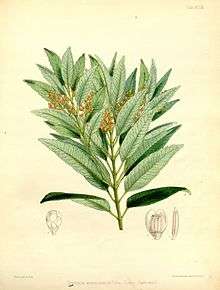Trimeniaceae
Trimeniaceae is a family of flowering plants recognized by most taxonomists, at least for the past several decades. It is a small family of one genus, Trimenia, with eight known species (Christenhusz & Byng 2016[1]) of woody plants, bearing essential oils. The family is subtropical to tropical and found in Southeast Asia, eastern Australia and on several Pacific Islands.
| Trimeniaceae | |
|---|---|
 | |
| Trimenia weinmanniaefolia | |
| Scientific classification | |
| Kingdom: | Plantae |
| Clade: | Tracheophytes |
| Clade: | Angiosperms |
| Order: | Austrobaileyales |
| Family: | Trimeniaceae L.S.Gibbs |
| Genera | |
| |
Taxonomy
APG IV
The APG IV system, of 2016, recognizes this family and places it in order Austrobaileyales, an order which is accepted as being among the most basal lineages in the clade angiosperms.[2]
APG III
The APG III system, of 2009, also recognizes such a family and places it in order Austrobaileyales, an order which is accepted as being among the most basal lineages in the clade angiosperms.[3]
APG II
The APG II system, of 2003, also recognizes such a family and places it in order Austrobaileyales, an order which is accepted as being among the most basal lineages in the clade angiosperms.
APG
The APG system, of 1998, also recognized this family, but left it unplaced as to order, and regarded it as being among the most basal lineages in the clade angiosperms.
Cronquist
The Cronquist system, of 1981, accepted this family and placed it in
- the order Laurales,
- in subclass Magnoliidae,
- in class Magnoliopsida [=dicotyledons],
- of division Magnoliophyta [=angiosperms].
- in class Magnoliopsida [=dicotyledons],
- in subclass Magnoliidae,
Thorne
The Thorne system (1992) accepted this family and placed it in
- the order Magnoliales,
- in superorder Magnolianae,
- in subclass Magnoliideae [=dicotyledons],
- in class Magnoliopsida [=angiosperms].
- in subclass Magnoliideae [=dicotyledons],
- in superorder Magnolianae,
Dahlgren
The Dahlgren system accepted this family and placed it in
- the order Laurales,
- in superorder Magnolianae,
- in subclass Magnoliideae [=dicotyledons],
- in class Magnoliopsida [=angiosperms].
- in subclass Magnoliideae [=dicotyledons],
- in superorder Magnolianae,
Engler
The Engler system, in the update of 1964, accepted this family and placed it in
- the order Magnoliales, which was placed
- in subclass Archychlamydeae,
- in class Dicotyledoneae,
- in subdivision Angiospermae
- in class Dicotyledoneae,
- in subclass Archychlamydeae,
References
- Christenhusz, M. J. M. & Byng, J. W. (2016). "The number of known plants species in the world and its annual increase". Phytotaxa. 261 (3): 201–217. doi:10.11646/phytotaxa.261.3.1.
- Angiosperm Phylogeny Group (2016). "An update of the Angiosperm Phylogeny Group classification for the orders and families of flowering plants: APG IV". Botanical Journal of the Linnean Society. 181 (1): 1–20. doi:10.1111/boj.12385. ISSN 0024-4074.CS1 maint: uses authors parameter (link)
- Angiosperm Phylogeny Group (2009). "An update of the Angiosperm Phylogeny Group classification for the orders and families of flowering plants: APG III". Botanical Journal of the Linnean Society. 161 (2): 105–121. doi:10.1111/j.1095-8339.2009.00996.x. Archived from the original (PDF) on 2017-05-25.
References and external links
- Trimeniaceae in L. Watson and M.J. Dallwitz (1992 onwards) The families of flowering plants: descriptions, illustrations, identification, information retrieval. Version: 3 May 2006. http://delta-intkey.com.
- e-flora
- NCBI Taxonomy Browser